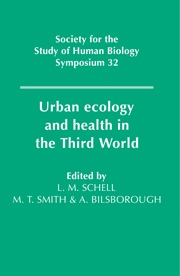Book contents
- Frontmatter
- Contents
- List of contributors
- Acknowledgements
- 1 Human biological approaches to the study of Third World urbanism
- 2 Social and cultural influences in the risk of cardiovascular disease in urban Brazil
- 3 The urban disadvantage in the developing world and the physical and mental growth of children
- 4 Differences in endocrine status associated with urban-rural patterns of growth and maturation in Bundi (Gende-speaking) adolescents of Papua New Guinea
- 5 Nutritionally vulnerable households in the urban slum economy: a case study from Khulna, Bangladesh
- 6 Urban-rural differences in growth and diarrhoeal morbidity of Filipino infants
- 7 Child health and growth in urban South Africa
- 8 From countryside to town in Morocco: ecology, culture and public health
- 9 Urban-rural population research: a town like Alice
- 10 Selection for rural-to-urban migrants in Guatemala
- 11 Health and nutrition in Mixtec Indians: factors influencing the decision to migrate to urban centres
- 12 Urban health and ecology in Bunia, N.E. Zaire, with special reference to the physical development of children
- 13 Food for thought: meeting a basic need for low-income urban residents
- 14 Immunological parameters in northeast Arnhem Land Aborigines: consequences of changing settlement patterns and lifestyles
- 15 Amerindians and the price of modernisation
- 16 Sex ratio determinants in Indian populations: studies at national, state and district levels
- 17 Polarisation and depolarisation in Africa
- 18 Urbanisation in the Third World: health policy implications
- Index
8 - From countryside to town in Morocco: ecology, culture and public health
Published online by Cambridge University Press: 26 December 2009
- Frontmatter
- Contents
- List of contributors
- Acknowledgements
- 1 Human biological approaches to the study of Third World urbanism
- 2 Social and cultural influences in the risk of cardiovascular disease in urban Brazil
- 3 The urban disadvantage in the developing world and the physical and mental growth of children
- 4 Differences in endocrine status associated with urban-rural patterns of growth and maturation in Bundi (Gende-speaking) adolescents of Papua New Guinea
- 5 Nutritionally vulnerable households in the urban slum economy: a case study from Khulna, Bangladesh
- 6 Urban-rural differences in growth and diarrhoeal morbidity of Filipino infants
- 7 Child health and growth in urban South Africa
- 8 From countryside to town in Morocco: ecology, culture and public health
- 9 Urban-rural population research: a town like Alice
- 10 Selection for rural-to-urban migrants in Guatemala
- 11 Health and nutrition in Mixtec Indians: factors influencing the decision to migrate to urban centres
- 12 Urban health and ecology in Bunia, N.E. Zaire, with special reference to the physical development of children
- 13 Food for thought: meeting a basic need for low-income urban residents
- 14 Immunological parameters in northeast Arnhem Land Aborigines: consequences of changing settlement patterns and lifestyles
- 15 Amerindians and the price of modernisation
- 16 Sex ratio determinants in Indian populations: studies at national, state and district levels
- 17 Polarisation and depolarisation in Africa
- 18 Urbanisation in the Third World: health policy implications
- Index
Summary
Introduction
In contrast with many other developing countries, urban life is traditional in Morocco. The main cities (Fes, Rabat, Marrakesh, Meknes) were built before the thirteenth century and have historically been, in a natural region or at the bounds of tribal areas, centres for trade, law, religion and learning, in agreement with the Muslim tradition. The secular interaction of these cities with their surrounding countryside remained balanced until the beginning of the twentieth century, through the domination of urban influence.
The modern type of urbanisation, aggregating a composite population, is also present. A first ‘nucleus ’ including the harbour of Casablanca, Morocco's biggest town, and Rabat, the capital, absorbed most demographic increments until independence. From the 1960s onwards, however, these centres alone could no longer accommodate the rising velocity of population growth, and new urbanism spread to surrounding places, namely the harbours of Mahommedia, Sale and Kenitra. Thus, in contrast with tradition, modern urbanisation moved from inner provinces to the Atlantic shore, along with the translation of leading economic activity towards international trade.
In this process, the old cities (Fes, Marrakesh, Meknes), though also growing and maintaining their traditional functions, could not offer attractive prospects of employment. According to a Moroccan economist (Bentahar, 1987) they would become a relay between the small towns, the first levels of urban life, and the Atlantic conurbation, and instead of evolving toward increased urban patterns, would on the contrary be invested with a new ‘ruralisation’.
- Type
- Chapter
- Information
- Urban Ecology and Health in the Third World , pp. 115 - 128Publisher: Cambridge University PressPrint publication year: 1993
- 1
- Cited by



